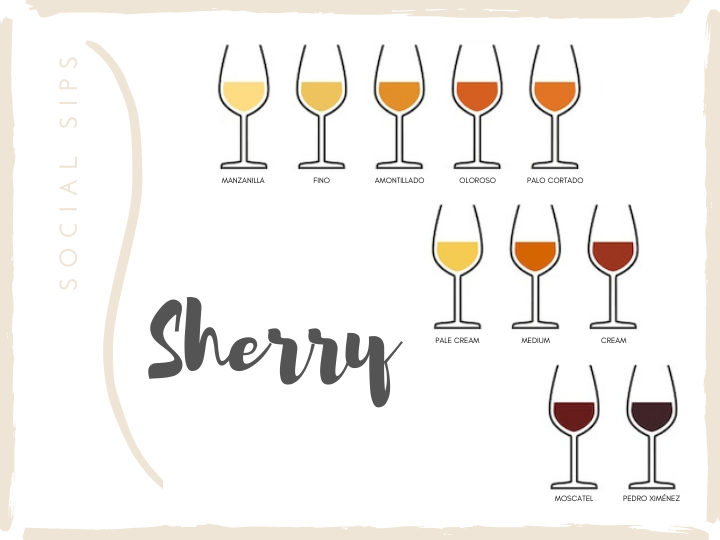As you may know, I embarked on my Spanish Wine Scholar accreditation earlier this Spring through the Wine Scholar Guild (you might remember I tackled Albariño in an article not too long ago). SWS students get an entire year to study and pass the exam and I was smoothly sailing through the instructor-led webinars and kept up with the reading and self-study until I hit the chapter on the styles of sherry.
Sherry is a beast. It has many components and is a spider web of different winemaking principles. I couldn’t get my head around. So, I made a grid! I’m a very visual and linear learner. I needed to create something that made me go, ‘Ooh – that makes sense.’ So that’s what this post is. I’m sharing my process to help clarify the styles of sherry and understand how each is made.
The Beginning
First, it helps to understand the styles of sherry. There are five types of dry sherry: two types that are naturally sweet and four types that are sweetened by blending.
Next, let’s recognize that dry sherry (Vinos Generosos) is made only from the palomino grape. The other two allowed grapes (Muscatel and Pedro Ximenez) make naturally sweet wine (Vinos Dulces Naturales). They are used later to create sherry blends (Vinos Generosos De Licor).
I won’t get too much into explaining the pressing process or how each classification is determined. If you’re an SWS or WSET Diploma student, you know where to find that information. I’m just here to provide the path!

Building Personality
After the first classification (i.e. determining which wines will be Fino versus which are better suited to be Oloroso), they’re fortified to their determinant level and left to develop the first of the character before entering the solera system.
This ‘hurry up and wait’ zone is the sobretabla stage, lasting anywhere from three to twelve months. Afterwards, the wine undergoes a secondary classification to ensure its determined characteristics are on track. If, at this stage, it’s not worthy of sherry production, it gets used to make sherry vinegar.

Solera Time
Here’s where I went from “What the ??” to “Oooooooooh.” For instance, the only difference between Manzanillo and Fino is where it’s produced and matured.
Amontillado essentially starts as a biologically aged Fino, but if the flor dies (intentionally or accidentally), its aging continues oxidatively after being refortified.
Palo Cortado is one of the more rare styles. It’s classified for biological aging but is removed from under the flor sooner, refortified to 17% and then aged the remainder of its time oxidatively.
The last of the dry sherries is Oloroso, destined for oxidative aging from the beginning due to its greater structure.
If you need a refresher on what a solera is, visit here.

I should mention a sixth sub-type of dry sherry called En Rama. Over the past decade or so, some producers have chosen to produce a more natural – lightly filtered – sherry wine. So, if you see a biologically aged sherry with En Rama on the label, know that it’s undergone minimal filtration. FYI, you won’t see this on an Oloroso (i.e. oxidatively aged) sherry wine.
And Now, This
This party isn’t over yet.
From here, sherry producers say to themselves, “Why stop there? let’s give the people what they want – sugar!” It’s true. With the addition of Rectified Concentrated Grape Must (RCGM), Manzanilla and Fino can become Dry, Pale, or Pale Dry as long as the grams per litre stay under 45.
If you need a reference for sugar levels in wine, check out this article I wrote not too long ago.

You’ll notice that if the grams per litre is higher than 45 (up to 115), then it’s a Pale Cream.
Amontillado can also have up to 115 g/L, but producers can create that sweetness with RCGM, Muscatel, or Pedro Ximinez. Remember, they were both partially fermented in the beginning to create naturally sweet wines.
And finally, Oloroso can create the sweetest style of blended sherry: cream sherry. Using only the addition of PX, it can have sugar anywhere between 115 and 140 g/L.
Phew
So, that’s it. Easy, right?
Don’t worry, I know it’s not simple. But I hope this has helped you understand the styles of sherry in whatever studies you’re pursuing. Please let me know if this has helped you or if you spot any way I can make these grids easier to understand.

